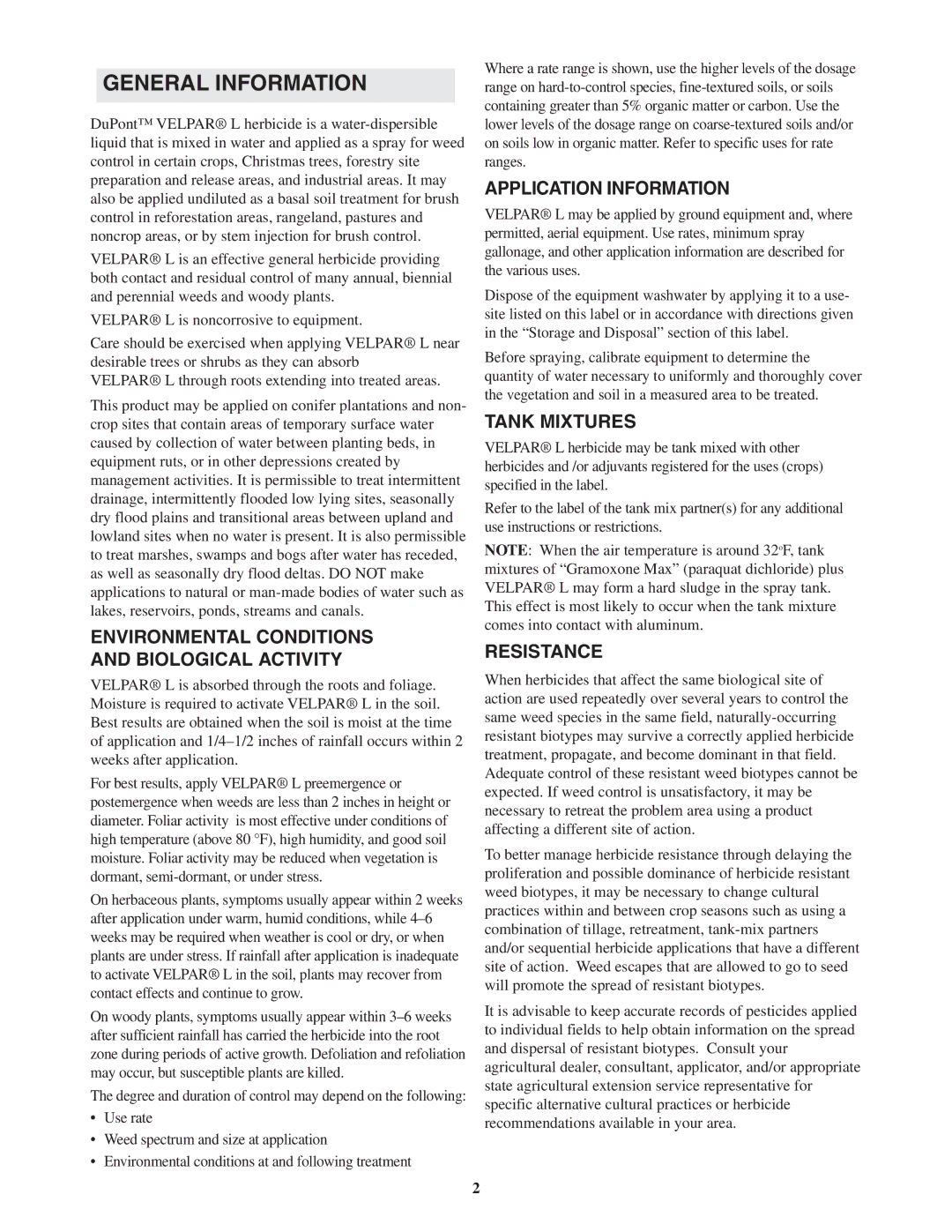GENERAL INFORMATION
DuPont™ VELPAR® L herbicide is a water-dispersible liquid that is mixed in water and applied as a spray for weed control in certain crops, Christmas trees, forestry site preparation and release areas, and industrial areas. It may also be applied undiluted as a basal soil treatment for brush control in reforestation areas, rangeland, pastures and noncrop areas, or by stem injection for brush control.
VELPAR® L is an effective general herbicide providing both contact and residual control of many annual, biennial and perennial weeds and woody plants.
VELPAR® L is noncorrosive to equipment.
Care should be exercised when applying VELPAR® L near desirable trees or shrubs as they can absorb
VELPAR® L through roots extending into treated areas.
This product may be applied on conifer plantations and non- crop sites that contain areas of temporary surface water caused by collection of water between planting beds, in equipment ruts, or in other depressions created by management activities. It is permissible to treat intermittent drainage, intermittently flooded low lying sites, seasonally dry flood plains and transitional areas between upland and lowland sites when no water is present. It is also permissible to treat marshes, swamps and bogs after water has receded, as well as seasonally dry flood deltas. DO NOT make applications to natural or man-made bodies of water such as lakes, reservoirs, ponds, streams and canals.
ENVIRONMENTAL CONDITIONS AND BIOLOGICAL ACTIVITY
VELPAR® L is absorbed through the roots and foliage. Moisture is required to activate VELPAR® L in the soil. Best results are obtained when the soil is moist at the time of application and 1/4–1/2 inches of rainfall occurs within 2 weeks after application.
For best results, apply VELPAR® L preemergence or postemergence when weeds are less than 2 inches in height or diameter. Foliar activity is most effective under conditions of high temperature (above 80 °F), high humidity, and good soil moisture. Foliar activity may be reduced when vegetation is dormant, semi-dormant, or under stress.
On herbaceous plants, symptoms usually appear within 2 weeks after application under warm, humid conditions, while 4–6 weeks may be required when weather is cool or dry, or when plants are under stress. If rainfall after application is inadequate to activate VELPAR® L in the soil, plants may recover from contact effects and continue to grow.
On woody plants, symptoms usually appear within 3–6 weeks after sufficient rainfall has carried the herbicide into the root zone during periods of active growth. Defoliation and refoliation may occur, but susceptible plants are killed.
The degree and duration of control may depend on the following:
•Use rate
•Weed spectrum and size at application
•Environmental conditions at and following treatment
Where a rate range is shown, use the higher levels of the dosage range on hard-to-control species, fine-textured soils, or soils containing greater than 5% organic matter or carbon. Use the lower levels of the dosage range on coarse-textured soils and/or on soils low in organic matter. Refer to specific uses for rate ranges.
APPLICATION INFORMATION
VELPAR® L may be applied by ground equipment and, where permitted, aerial equipment. Use rates, minimum spray gallonage, and other application information are described for the various uses.
Dispose of the equipment washwater by applying it to a use- site listed on this label or in accordance with directions given in the “Storage and Disposal” section of this label.
Before spraying, calibrate equipment to determine the quantity of water necessary to uniformly and thoroughly cover the vegetation and soil in a measured area to be treated.
TANK MIXTURES
VELPAR® L herbicide may be tank mixed with other herbicides and /or adjuvants registered for the uses (crops) specified in the label.
Refer to the label of the tank mix partner(s) for any additional use instructions or restrictions.
NOTE: When the air temperature is around 32oF, tank mixtures of “Gramoxone Max” (paraquat dichloride) plus VELPAR® L may form a hard sludge in the spray tank. This effect is most likely to occur when the tank mixture comes into contact with aluminum.
RESISTANCE
When herbicides that affect the same biological site of action are used repeatedly over several years to control the same weed species in the same field, naturally-occurring resistant biotypes may survive a correctly applied herbicide treatment, propagate, and become dominant in that field. Adequate control of these resistant weed biotypes cannot be expected. If weed control is unsatisfactory, it may be necessary to retreat the problem area using a product affecting a different site of action.
To better manage herbicide resistance through delaying the proliferation and possible dominance of herbicide resistant weed biotypes, it may be necessary to change cultural practices within and between crop seasons such as using a combination of tillage, retreatment, tank-mix partners and/or sequential herbicide applications that have a different site of action. Weed escapes that are allowed to go to seed will promote the spread of resistant biotypes.
It is advisable to keep accurate records of pesticides applied to individual fields to help obtain information on the spread and dispersal of resistant biotypes. Consult your agricultural dealer, consultant, applicator, and/or appropriate state agricultural extension service representative for specific alternative cultural practices or herbicide recommendations available in your area.
